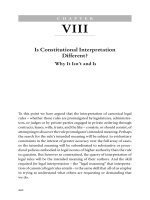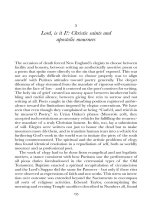Is Constitutional Interpretation Different. Why It Isn’t and Is
Bạn đang xem bản rút gọn của tài liệu. Xem và tải ngay bản đầy đủ của tài liệu tại đây (93.08 KB, 13 trang )
P1: KNP Top Margin: 0.50186in Gutter Margin: 0.94101in
c08 cuus142 ISBN: 978 0 521 70395 6 March 23, 2008 11:26
CHAPTER
VIII
Is Constitutional Interpretation
Different?
Why It Isn’t and Is
To this point we have argued that the interpretation of canonical legal
rules – whether those rules are promulgated by legislatures, administra-
tors, or judges or by private parties engaged in private ordering through
contracts, leases, wills, trusts, and the like – consists, or should consist, of
attempting to discover the rule promulgator’s intended meaning. Perhaps
the search for the rule’s intended meaning will be subject to evidentiary
constraints in the interest of greater accuracy over the full array of cases,
or the intended meaning will be subordinated to substantive or proce-
dural policies embodied in legal norms of higher authority than the rule
in question. But however so constrained, the quarry of interpretation of
legal rules will be the intended meaning of their authors. And the skill
required for legal interpretation – the “legal reasoning” that interpreta-
tion of canonical legal rules entails – is the same skill that all of us employ
in trying to understand what others are requesting or demanding that
we do.
220
P1: KNP Top Margin: 0.50186in Gutter Margin: 0.94101in
c08 cuus142 ISBN: 978 0 521 70395 6 March 23, 2008 11:26
IS CONSTITUTIONAL INTERPRETATION DIFFERENT
? 221
In this brief chapter, we ask whether intentionalism of the sort we
have described is the appropriate methodology for interpreting a con-
stitution, the supreme law of the land. As readers no doubt are aware,
intentionalism of the straightforward, unsophisticated type that we have
been urging is nowhere as much disdained by legal theorists as in the
domain of constitutional interpretation. Yet we maintain that intention-
alism is as appropriate in constitutional interpretation as it is elsewhere.
We have already in Chapter 7 made our case against textualism,
which is often pitted against intentionalism in the battle of interpretive
methodologies for constitutional law. And in Chapter 5 we argued that
those who author constitutional provisions do not necessarily intend the
priority of concepts over specific conceptions, or of the best theory of the
thing referred to over its conventional definition, or its definition over
its exemplars. The priority relation will vary with the provision because
the intent will vary. If the authors intend by a particular provision to
enact a standard rather than a rule, then their intent – in effect, their
rule – is to delegate authority to the interpreter to decide what should be
done. If, however, they intend to enact a rule, then they are attempting
themselves to settle what should be done, and their settlement is whatever
they intend it to be. This outcome is as true for authors of constitutional
provisions as it is for legislatures, administrators, judges, and private
orderers.
This, as we said, is ground we have already covered. In this chapter,
we discuss four challenges to intentionalist constitutional interpretation
beyond those previously dealt with: the methodology of “the living Con-
stitution,” the methodology of the “paradigm case,” the effect of Supreme
Court precedents on interpretation, and the challenge of changes in “the
rule of recognition.” The first two challenges fail completely. The last
two challenges do not affect how the Constitution should be interpreted
in the sense of challenging intentionalism, but they do raise questions
about the Constitution’s authority and its identity.
I. The Constitution as Super Statute
Our view – and we believe it is the ordinary view – is that interpreting
a constitution is not different in any material way from interpreting a
P1: KNP Top Margin: 0.50186in Gutter Margin: 0.94101in
c08 cuus142 ISBN: 978 0 521 70395 6 March 23, 2008 11:26
222
REASONING FROM CANONICAL LEGAL TEXTS
statute. The U.S. Constitution is, of course, “higher law” than any statute.
1
Moreover, substantial parts of it are more than two hundred years old
(although many statutes are of similar vintage). And, if one deems its
“authors”tobenotthosewhodrafteditbutratherthosewhoratified
it – although the ratifiers were most likely voting on what they believed
were the drafters’ intended meanings – then the constitutional authors
constitute a more numerous and diffuse group than the legislatures that
author statutes, though the latter are usually bicameral and include the
chief executive in the legislative process. None of these characteristics
of the Constitution, however, make it different in kind from a statute.
And therefore, there is no reason why the same intentionalism that
should guide statutory and all other legal interpretation should not guide
constitutional interpretation.
One argument occasionally raised against intentionalism in con-
stitutional interpretation rests on a misunderstanding of intentional-
ism. Its proponents point out that many clauses in the Constitution
appear to invoke moral concepts like “equality,” “liberty,” “freedom of
speech,” “free exercise of religion,” “reasonable cause,” and “cruel and
unusual punishment.” They go on to argue that these clauses should
be interpreted according to the interpreter’s best understanding of the
moral reality to which those concepts refer, and not according to the
Constitution’s authors’ particular understanding of those concepts and
how they might apply.
2
Thus, for example, if the death penalty is really
“cruel and unusual,” it should be deemed unconstitutional, even if the
authors of the Constitution would not have thought that it was. Or, if
official gender discrimination is really a denial of “equal protection,”
it should not matter that the authors of the Fourteenth Amendment
did not believe the amendment applied to gender discrimination. And
so on.
Now, nothing in this argument is inconsistent with intentionalist
constitutional interpretation. As we made clear in Chapter 5, particu-
larly in our discussion of Bassham,
3
and again at the end of Chapter 7,
4
1
See U.S. Const. Art. VI. cl. 2: “This Constitution . . . shall be the supreme Law of the Land.”
2
See Ronald Dworkin, Comment, in Antonin Scalia, A Matter of Interpretation: Federal Courts
and the Law 115–27 (Princeton: Princeton University Press 1997).
3
See Chapter 5, supra text at notes 32–41.
4
See Chapter 7, supra text at note 48.
P1: KNP Top Margin: 0.50186in Gutter Margin: 0.94101in
c08 cuus142 ISBN: 978 0 521 70395 6 March 23, 2008 11:26
IS CONSTITUTIONAL INTERPRETATION DIFFERENT
? 223
constitutional authors, in using a particular term, may have in mind
particular exemplars of that term, which exemplars they believe are con-
sistent with a definition they also have in mind, which definition they
believe captures the true nature of the term’s referent. Where, from
the standpoint of the interpreter, the exemplars, the definition, and the
true nature of the thing come apart, it is an open question whether
the term’s authors intended the exemplars, the definition, or the true
nature to control the term’s application. We can imagine circumstances
that would support the dominance of exemplars of the term, the dom-
inance of the conventional definition of the term, or the dominance
of the real nature of the term. The intentionalist seeks the dominant
authorial intention.
If, therefore, the constitutional authors did indeed intend for the
real nature of the various terms that seem value-laden to control and to
dominate the authors’ possibly mistaken definitions and exemplars, then
the interpreter of those terms must seek their true nature and not what the
constitutional authors believed that nature to be. That is intentionalist
interpretation, not something else. The constitutional authors would
essentially be saying to their interpreters, we intend by these terms in
theseclausesforyoutoseekoutthetruenatureofequality,liberty,and
so forth and gauge the validity of ordinary laws by whether they are
consistent with what you discover.
We should, however, caution against too hasty an assumption that
the Constitution contains terms of this type – that is, terms by which the
authors intended to refer to “moral reality.” Many legal norms are wholly
or in part “standards” rather than “rules.” That is, the norms delegate
to some other decision maker – the citizen, the administrator, or the
judge – the task of determining what should be done. The authors of
the hypothetical legal standard “drive at a reasonable speed” prescribed
such a standard because they would not or did not want to prescribe in
rulelike fashion a rigid code of speed limits. The driver, or the judge who
must assess the driver’s conduct, or the administrator who must post a
speed limit for the curve on Elm Street must decide what a “reasonable
speed” is at a particular time or place. The authors of the standard did
not settle that issue. Rules settle, standards delegate.
It should be kept in mind, however, that ordinarily, standards delegate
only within the boundaries set by rules. The “reasonable” speed limit
P1: KNP Top Margin: 0.50186in Gutter Margin: 0.94101in
c08 cuus142 ISBN: 978 0 521 70395 6 March 23, 2008 11:26
224
REASONING FROM CANONICAL LEGAL TEXTS
deals only with driving speeds. It does not affect other domains of life.
Similarly, a statute instructing a judge to impose a “fair” punishment for
a crime deals only with that crime and with the punishment thereof.
In interpreting the “moralized” clauses of the Constitution, we can
imagine that their authors intended for them to be rule-bounded stan-
dards, delegating to future interpreters the task of deciding what “equal-
ity,” or “freedom of speech,” or “liberty” means within the boundaries
established by the Constitution’s determinate rules (themselves prod-
ucts of the authors’ intended meanings). But the true nature of equality,
liberty, and so forth may not respect such rule-defined boundaries.
So consider the possibility that the “true nature” of liberty, say, or
equality demands that we have a thoroughly centralized government (no
state or local governments), a unicameral national legislature (no Senate),
a lower burden of proof in criminal trials than “beyond a reasonable
doubt,” and so on. In other words, it might be the case that much of
what our Constitution requires or presupposes is inconsistent with the
“true nature” of political morality. If the Constitution’s authors really did
intend by these moralized clauses for us to implement the true nature
of equality, liberty, and the like, then they intended in those clauses to
repudiate much or perhaps all of what they intended the rest of the
Constitution to establish.
5
Now their intentions might have been deeply conflictual in this way.
But we think one should be cautious before assuming too quickly that
they really did intend in a handful of the Constitution’s many provi-
sions to open the door to interpreters’ repudiating clearly established
constitutional rules and structures.
(As an aside, but one illustrative of the problem, consider that the
Supreme Court has held that the Fourteenth Amendment’s equal pro-
tection clause condemns state senates that, like the United States Senate,
are not apportioned according to “one person, one vote.”
6
And consider
that the Court has often held that the principles of equal protection are
5
See Larry Alexander and Frederick Schauer, Law’s Limited Domain Confronts Morality’s Uni-
versal Empire, 48 William & Mary l. Rev. 1579, 1595–99 (2007).
6
See Reynolds v. Sims, 377 U.S. 533 (1964) (holding unconstitutional malapportioned state
senates).









